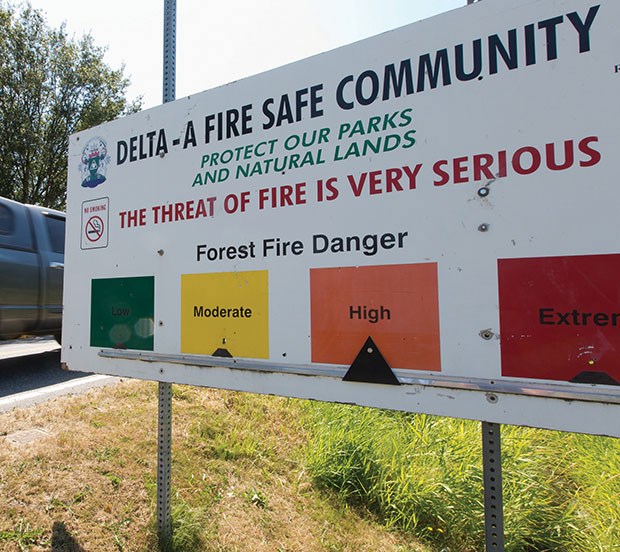Delta has plenty of areas at risk of fire due to the current conditions but the fire department is ready to respond.
That was the message from Delta fire Chief Dan Copeland in his presentation to Delta council this week about the department's preparedness measures during this spell of hot weather.
Noting the long range forecast is for warm, dry conditions, Copeland said an open burning ban is in effect for all areas and that fire, police and bylaw staff are patrolling parks, beaches and wilderness areas daily.
The current fire hazard rating is high, but can move up to extreme depending on how hot things get over the coming days. The immediate forecast calls for continued sunshine and high temperatures into next week. Warning boards with the most current hazard rating can fluctuate quickly between moderate and high. An extreme fire hazard would mean the closure of places like the Delta Nature Reserve and Watershed Park.
Burns Bog remains an area of great concern due to its vulnerability, even though most of the bog is closed to the public. The bog has experienced several difficult fires over the years and even the recent short period of rainfall doesn't help much, warned Copeland.
He said more than just a few days of rain are needed to penetrate the vegetation canopy covering the ground. Noting the situation is monitored closely, Copeland said significant penetration usually doesn't occur until one or two weeks of rain.
Several years ago, a fired burned for a week in a 200-hectare area in the southeast corner of the bog, a fire believed to have been started by human activity. A few years earlier another large fire, which burned for a couple of weeks, was believed to have started from a cigarette butt.
A bog fire is particularly difficult to handle because it goes underground, spreading in many directions.
The department devised a Burns Bog Fire Management Plan operations manual aimed at helping firefighters quickly and effectively deal with bog blazes.
Last year, the department received its order of two new vehicles designed to help fight difficult fires, including a Wildland 2 quick response truck, a four-wheel drive vehicle that was the first of its kind in the province. The truck is built to maneuver around some of the unique and challenging terrain.
Meanwhile, a community wildfire protection plan that's been in place since 2009 includes regular wildland firefighter training, while a special exercise was also conducted this year with Metro Vancouver.
Copeland said park users are also a valuable resource.
"The people who use the nature reserve and Watershed Park, they're our best stewards in the area. They're our eyes and ears out there and help us protect it," he said.
Some preventative measures that have been carried out included working with the engineering and parks departments to identify potentially vulnerable areas. That resulted in a pathways program, which involved thinning out trees and vegetation close to paths at Watershed Park and the nature reserve.
Copeland said the department also follows a provincial manual to identify urban interface areas, including homes abutting heavily vegetated areas.



